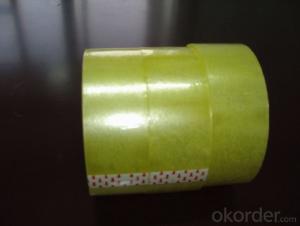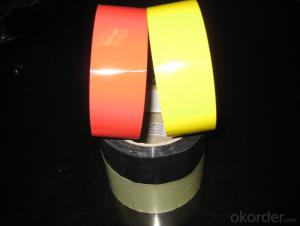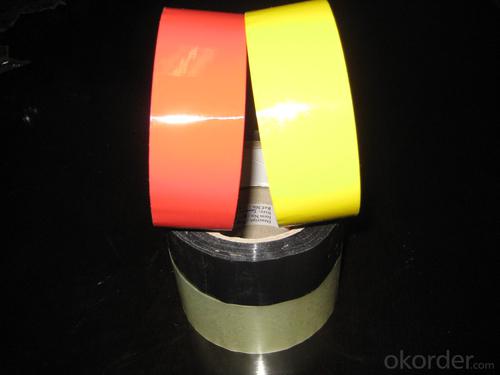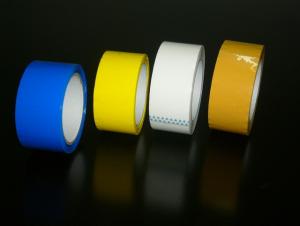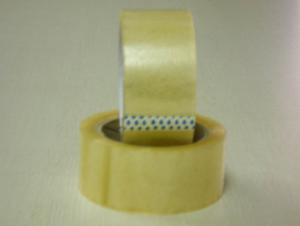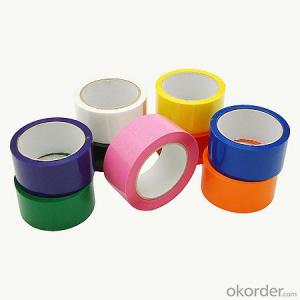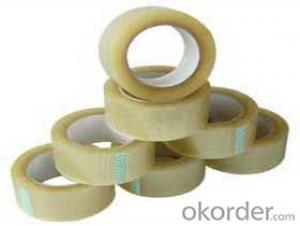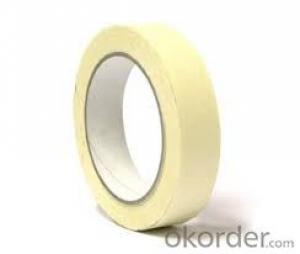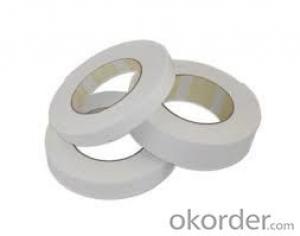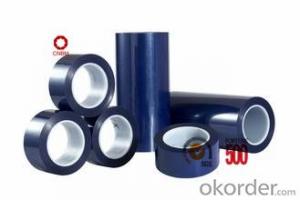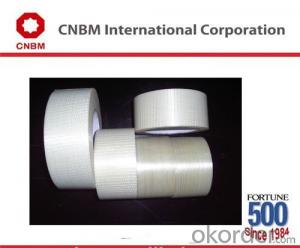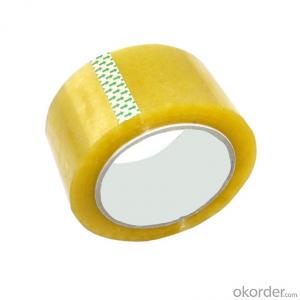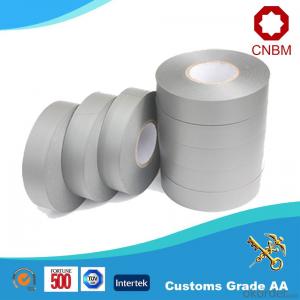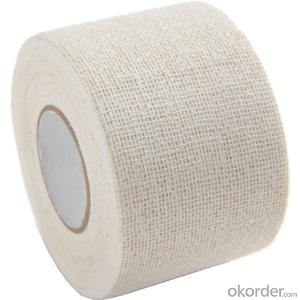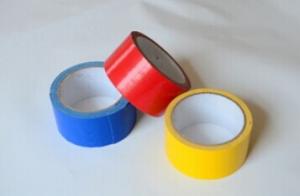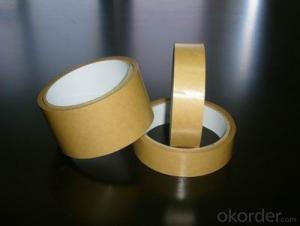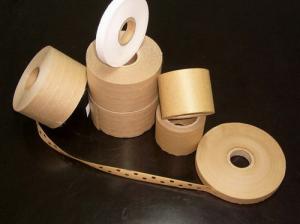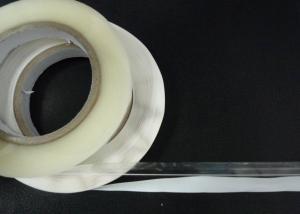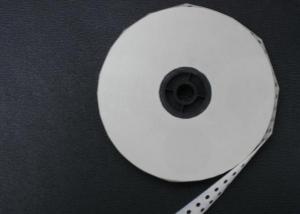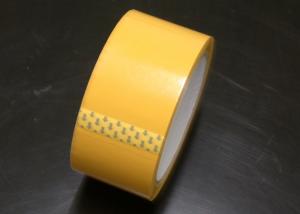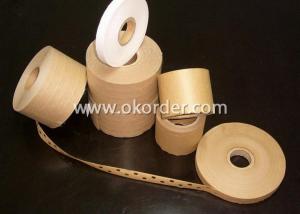Fabric Packaging Tape - Cheap Price 40 Micron
- Loading Port:
- China Main Port
- Payment Terms:
- TT OR LC
- Min Order Qty:
- -
- Supply Capability:
- -
OKorder Service Pledge
OKorder Financial Service
You Might Also Like
CONSTRUCTION:
Carrier: BOPP film
Adhesive: Water based acrylic adhesive.
TYPICAL PHYSICAL PROPERTIES:
Total Thickness (adhesives + carrier): 40 ± 2 um
Initial Tack (11mm steel ball): ³ 18#
180O Peel Adhesion (to steel): ³ 0.5 kgf /25mm
Holding Power: ³ 24 hrs
Tensile Strength: ³ 30 N/cm
Elongation: ≤180%
PACKING:
Core I.D.: 3” (76mm±1)
Jumbo Roll:1280mm x 4000m
Cut Roll: As per customer’s requirements
Application:
Carton sealing & packing, Light duty packaging, bundling, holding, and other office & household use.
REMARKS:
1. The data above are typical results and subject to change without notice.
2. Tolerance: Weight and Thickness: ±10%; Width: ±3mm;
Length: Cut Roll & Log Roll ±0.3m, Jumbo Roll ±0.5%.
3. The products should be stored at room temperature and be kept away wet and/or heat source.
4. It is essential, as with all pressure-sensitive tapes, that the surface to which the tape is applied must be clean, dry, and free of grease and oil.
5. The users should take test and do trial-application on the above products before coming into application so as to witness and ensure suitability for their special purpose and technique.
- Q: Is packaging tape safe to use on mirrors?
- In general, using packaging tape on mirrors is considered safe. This tape is known for its strength and adhesive properties, which are intended to effectively hold objects in place. Nevertheless, it is crucial to consider the specific type of packaging tape being used, as it can impact the tape's safety when applied to mirrors. Opting for clear packaging tapes or tapes specially made for glass surfaces is typically the wisest choice in order to prevent any potential harm or residue on the mirror. Moreover, it is advisable to conduct a preliminary test on a small, inconspicuous area of the mirror to ensure proper adhesion and to avoid any potential damage.
- Q: How do I prevent packaging tape from tearing during removal?
- To avoid tearing when removing packaging tape, consider the following strategies: 1. Applying heat proves effective. Utilize a hairdryer or heat gun to warm the tape. The adhesive softens, facilitating tear-free removal. Exercise caution to prevent overheating or scorching. 2. A cutting tool, such as a utility knife or scissors, can be employed when tape removal becomes challenging. Carefully cut through the tape to prevent tearing, opting for smaller, manageable sections. 3. Adopt a patient and deliberate approach. Remove the tape gradually and at a low angle, exerting gentle pressure to avoid tearing. If met with resistance, pause and attempt different angles or apply heat to loosen the adhesive. 4. If the tape proves stubborn, seek assistance from a solvent like rubbing alcohol or adhesive remover. Apply a small amount to a cloth or cotton ball and gently rub the tape to dissolve the adhesive. Test the solvent on a discreet area first to ensure it doesn't damage the surface. 5. Make an informed tape selection. Opt for high-quality packaging tape with strong adhesion and good tensile strength. Reinforced or heavy-duty tapes are less prone to tearing. By employing these techniques cautiously, you can successfully remove packaging tape without tearing it.
- Q: Can packaging tape be used for sealing packages with hazardous materials?
- No, packaging tape should not be used for sealing packages with hazardous materials. Hazardous materials require specific packaging and sealing methods to ensure the safety of those handling and transporting the package. In order to meet regulatory requirements, hazardous materials should be sealed using approved methods such as special hazard tape, tamper-evident seals, or specific hazardous material labels. These methods help to clearly identify the contents of the package, prevent leakage or spillage, and provide necessary warnings and precautions for those involved in the transportation and handling of hazardous materials.
- Q: Is packaging tape resistant to UV rays?
- Yes, packaging tape is generally resistant to UV rays. Most packaging tapes are made from materials like polypropylene or polyethylene, which have inherent resistance to UV radiation. This means that the tape can withstand exposure to sunlight and other sources of UV rays without deteriorating or losing its adhesive properties. However, it is important to note that prolonged exposure to UV rays can still cause some degradation over time. To ensure maximum longevity, it is recommended to store and use packaging tape in a cool, dry place away from direct sunlight whenever possible.
- Q: Does packaging tape have a specific adhesive strength?
- Yes, packaging tape typically has a specific adhesive strength which is designed to securely seal boxes and packages. The adhesive strength can vary depending on the brand and type of packaging tape being used.
- Q: Can packaging tape be used for sealing containers with liquids?
- Indeed, packaging tape is capable of sealing containers holding liquids. Nevertheless, it is crucial to acknowledge that not all packaging tapes are formulated to endure prolonged exposure to liquids. In the case of sealing liquid-containing containers, it is advisable to opt for packaging tape explicitly engineered for this purpose, such as water-resistant or waterproof tape. These varieties of tape are typically more robust and possess heightened adhesive qualities to guarantee a firm seal and prevent leakage. Moreover, it is prudent to cleanse and thoroughly dry the container's surface prior to tape application to ensure optimal adhesion.
- Q: Can packaging tape be used for sealing furniture or home goods?
- Yes, packaging tape can be used for sealing furniture or home goods. Packaging tape is designed to provide a secure and strong seal, making it suitable for various purposes including sealing boxes and packages. When used on furniture or home goods, packaging tape can help keep the item protected during transportation or storage. It is important to ensure that the tape is applied properly and that it does not damage the surface or leave any residue. Additionally, depending on the weight and size of the item, it might be more appropriate to use specialized tapes or techniques for sealing furniture or home goods to ensure maximum protection.
- Q: How do I prevent packaging tape from becoming brittle?
- To prevent packaging tape from becoming brittle, make sure to store it in a cool, dry place away from direct sunlight. Exposure to extreme temperatures and humidity can cause the adhesive to deteriorate, leading to brittleness. Additionally, avoid overstretching or pulling on the tape too tightly during application, as this can weaken its structure. Finally, using a high-quality tape that is specifically designed for packaging purposes can also help prevent brittleness.
- Q: Can packaging tape be used for sealing packages with automotive parts or accessories?
- Indeed, the utilization of packaging tape is applicable for the sealing of packages encompassing automotive parts or accessories. With its purpose in securely sealing packages, packaging tape effectively ensures the cohesion of packages containing automotive parts or accessories. Through its robust adhesive bond, it guarantees that the package remains sealed throughout transportation or storage. Moreover, packaging tape commonly exhibits resistance to moisture, a crucial quality when shipping automotive parts or accessories susceptible to water damage.
- Q: How does packaging tape compare to duct tape in terms of strength and durability?
- Packaging tape and duct tape differ significantly in terms of strength and durability. Packaging tape is generally designed for sealing boxes and securing lightweight packages, making it suitable for general household use or light-duty applications. It typically has a lower tensile strength and may be more prone to tearing or breaking when subjected to substantial stress or weight. On the other hand, duct tape is renowned for its exceptional strength and durability. It is specifically engineered to provide a robust and long-lasting hold, making it the go-to choice for heavy-duty tasks and repairs. Duct tape is made from a strong woven fabric backing coated with a durable adhesive, resulting in a tape that can withstand high tension and resist tearing or breaking even under extreme conditions. While packaging tape is designed for temporary applications, duct tape is commonly used for more demanding and long-term projects, such as repairing or reinforcing items, bundling heavy objects, or even constructing temporary structures. Its versatility and superior strength make it a reliable choice in scenarios where durability and resilience are paramount. In summary, packaging tape and duct tape differ in their intended uses and capabilities. Packaging tape is suitable for lightweight applications and sealing boxes, while duct tape excels in heavy-duty tasks and offers exceptional strength and durability.
Send your message to us
Fabric Packaging Tape - Cheap Price 40 Micron
- Loading Port:
- China Main Port
- Payment Terms:
- TT OR LC
- Min Order Qty:
- -
- Supply Capability:
- -
OKorder Service Pledge
OKorder Financial Service
Similar products
Hot products
Hot Searches
